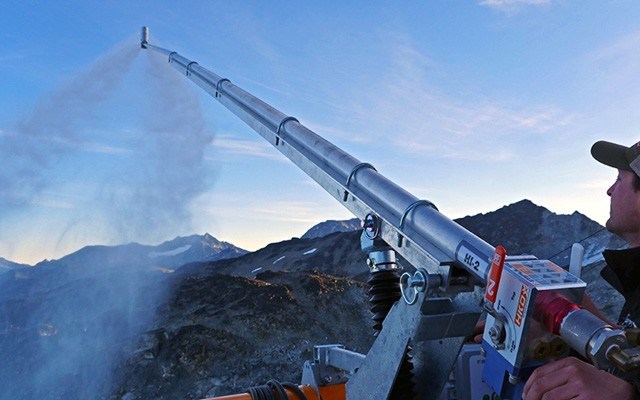When Whistler Blackcomb (WB) announced last year it would undertake a pilot project involving snowmaking on Horstman Glacier, the hope was that the project would help stabilize the steadily receding glacier.
But one year into the two-year pilot project, the results are not what the mountain operator hoped for.
"Our pilot project was intended to test the concept, and it didn't work," said Arthur De Jong, WB's mountain planning and environmental resource manager.
The snowmaking guns were aligned on the uppermost ridgeline of the glacier, De Jong explained, and the wind at that elevation proved challenging.
"In effect, we are mimicking nature, because glaciers feed or build a mass balance in their accumulation zone — which is the top half — so, theoretically, you want to feed it at the top," said Arthur De Jong.
"(But) it's too difficult with the wind. You cannot distribute the snow where you need it enough of the time... to be effective."
The project will continue this year with a new focus: using snow guns to improve entry and exit areas on the glacier, allowing for glacier skiing earlier in the season.
"This second stage of infrastructure investment is intended, at least in the midterm, to allow us to operate in a timely way for our winter operations," De Jong said.
"We know that in the longer term, the glacier will continue to recede... so from a planning standpoint what we're doing now is looking at how we reposition our lifts, our high-elevation infrastructure around the glacier... to optimize that high-elevation terrain, because it's always been critical to us, and it will be more critical and more important in the future."
De Jong didn't have any exact numbers, but estimated the Horstman Glacier has receded between one to two metres this year (a survey is planned for the coming weeks).
"We had hoped with the cool summer that we had, that maybe we would have had an equilibrium — no loss of the glacial mass balance — but clearly there has (been a loss) this year," he said.
"Not near as aggressive as the prior two years, where we had low snowpack winters followed by drought summers. Those are very impacting to the glacier. Last year we had an above average snowpack, cool summer, but we are still seeing some drop or retreat in the glacier."
Other glaciers on the south coast are facing a similar situation.
Wedgemount Glacier receded 34.8 metres last year, according to local researcher Karl Ricker.
"A significant amount, but not a record," Ricker wrote in a recent update.
"From 1941 to 1951 it averaged 46.6 metres per year and in 1969 to 1972 it was 36.6 metres per year. Thereafter, annual recessions were about one-third of those figures, but in the last eight years, the amounts have been in the high 20s."
This is the 44th year Wedgemount has been resurveyed.
"The ice terminus is no longer visible at the lake; a low rock ridge on the former glacier bed now blocks the view and another lake basin is quickly developing behind it," Ricker wrote.
"So, there is a 'lower' Wedgemount Lake and now an 'upper' lake — the snout of the glacier is on the upper."
A planned survey of Overlord Glacier likely won't happen this year, Ricker wrote, but if trends in the area are any indication, there's a good probability it has receded as well.
"That's the general state of glaciers in the south coast here — most are showing some retreat this year," De Jong said.
For WB, that reality means planning for ways to optimize existing infrastructure.
"It's challenging," De Jong said.
"I was up there last week with a glaciologist and geotechnical engineer and certainly we have a plan to optimize both the north side, where the Horstman Glacier is, and Blackcomb Glacier, as well as get more optimization off of the Seventh Heaven side.
"If we lower the ridge line, we would have much easier access onto both the Horstman Glacier side as well as the south side. We could, in effect, provide several access points onto south side Seventh Heaven."




